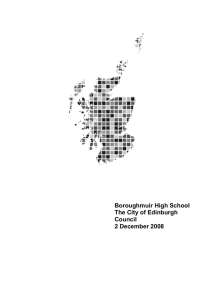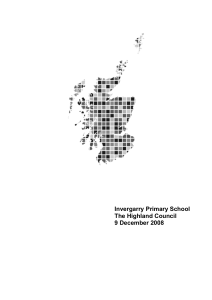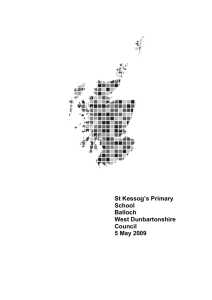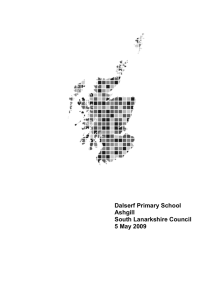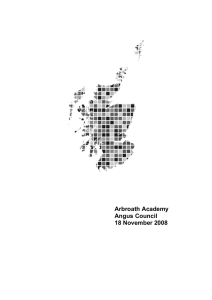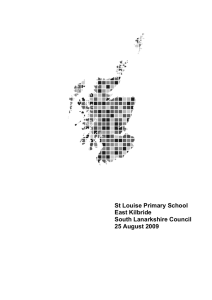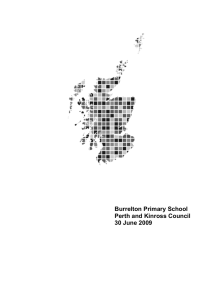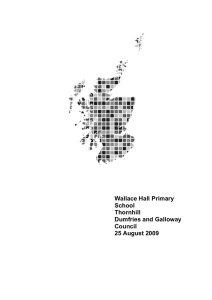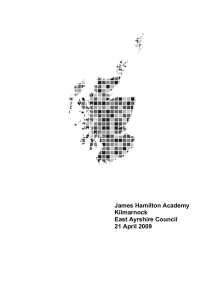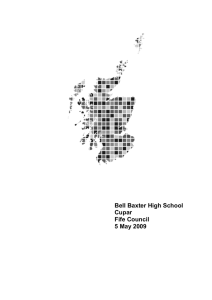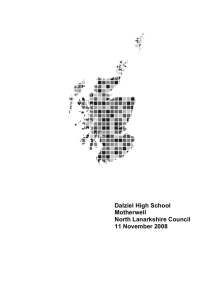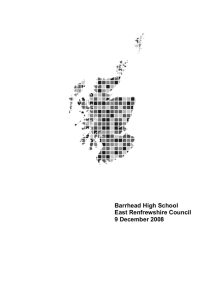Abronhill High School Cumbernauld North Lanarkshire Council
advertisement
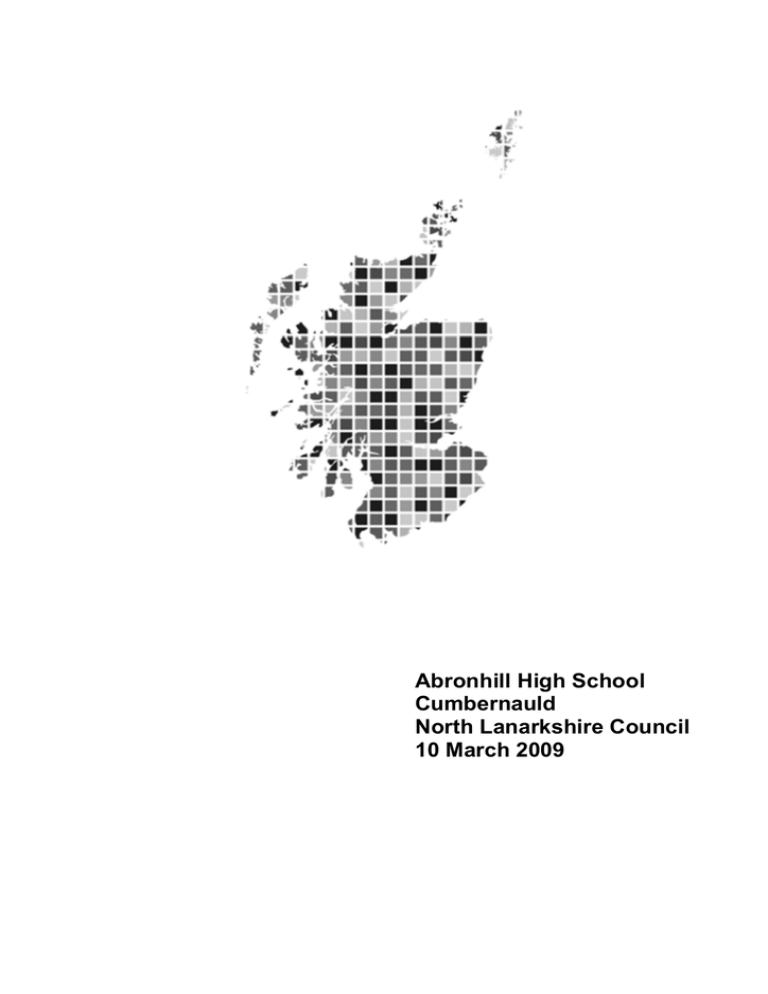
Abronhill High School Cumbernauld North Lanarkshire Council 10 March 2009 This report tells you about the quality of education at the school. We describe how young people benefit from learning there. We explain how well they are doing and how good the school is at helping them to learn. Then we look at the ways in which the school does this. We describe how well the school works with other groups in the community, including parents1 and services which support young people. We also comment on how well staff and young people work together and how they go about improving the school. Our report describes the ‘ethos’ of the school. By ‘ethos’ we mean the relationships in the school, how well young people are cared for and treated and how much is expected of them in all aspects of school life. Finally, we comment on the school’s aims. In particular, we focus on how well the aims help staff to deliver high quality learning, and the impact of leadership on the school’s success in achieving these aims. If you would like to learn more about our inspection of the school, please visit www.hmie.gov.uk. Here you can find analyses of questionnaire returns and details about young people’s examination performance. Where applicable, you will also be able to find descriptions of good practice in the school and a report on the learning community surrounding the school. 1 Throughout this report, the term ‘parents’ should be taken to include foster carers, residential care staff and carers who are relatives or friends. Contents 1. The school 2. Particular strengths of the school 3. Examples of good practice 4. How well do young people learn and achieve? 5. How well do staff work with others to support young people’s learning? 6. Are staff and young people actively involved in improving their school community? 7. Does the school have high expectations of all young people? 8. Does the school have a clear sense of direction? 9. What happens next? 1. The school Abronhill High School is a non-denominational school which serves the Abronhill district of Cumbernauld and surrounding areas. The inspection was carried out in January 2009 at which time the roll was 473. Young people’s attendance was in line with the national average in 2006/07. The school has been led by an acting headteacher between August 2008 and January 2009. A new headteacher took up his post in January 2009. 1 2. Particular strengths of the school • High-quality relationships between staff and young people. • Opportunities for broader achievement developed by staff and the school’s partners. • The positive morale, high levels of commitment and willingness of staff to innovate. • The quality and impact of the support provided by guidance and learning support staff. 3. Examples of good practice • The ‘Working with Others’ project in which young people in S5/S6 provide peer support for their younger peers in S1. • A Mountain Bike Project which enriches the physical education curriculum. 4. How well do young people learn and achieve? Learning and achievement Young people are happy and comfortable in school. They feel safe and well supported. Almost all are well motivated and the majority play an active part in lessons. They have very positive relationships with teachers and get on well with their peers. In a few classes they are not sufficiently challenged in their learning. Young people show respect for each other and for staff. They behave exceptionally well in class and in other parts of the school. The school successfully develops young people’s self confidence. Those in S6 are responsible, resourceful and creative in their approach to solving problems. The ‘Working with Others’ initiative has been very effective in helping young people in S6 to develop their personal skills in 2 preparation for leaving school. Young people demonstrate a sense of responsibility and have developed good citizenship skills through their involvement in the out-of-hours clubs and events. They benefit from team working, learn new skills and are improving their health and wellbeing by taking part in a range of activities. The school celebrates well young people’s achievements in sports activities. Individuals have achieved success at regional and national level in golf, swimming, football, tae kwon doe and athletics. Most young people develop their learning skills as they progress through the school but need to be encouraged to develop better and more resilient independent study skills. At S1/S2, young people are making good progress in English and mathematics. Standards of reading and writing have improved and young people have well-developed listening and talking skills. They have also made steady progress in other subjects. In comparison with schools which serve young people with similar needs and backgrounds, young people at S4 are performing well at Foundation and General levels. Performance is not as good at Credit level, and is uneven across the school. The results at Higher level in S5 and S6 are not as good as in schools which serve young people with similar needs and backgrounds. The school needs to improve the quality of these awards. The changes which teachers have recently introduced to the teaching of English and mathematics are producing promising results at Higher level. Curriculum and meeting learning needs The curriculum is well designed to support the school’s aim of meeting the learning needs of all young people. Teachers ensure that young people learn about health and wellbeing, enterprise and sustainable development. Staff have introduced inter-disciplinary projects which are motivating and providing further opportunities for young people to make links between different areas of learning. The school provides a growing range of courses and programmes to suit a variety of learning needs and career aspirations. For example, a new construction suite and strong links with local colleges support learning for work well. The 3 school has developed a new course option in Spanish which combines with travel and tourism to broaden learning experiences and develop skills. At each stage young people enjoy appropriate courses in physical education. Transition arrangements from P7 to S1 are well organised and help young people to fit in to the school. As part of induction arrangements, the school offers a week of summer school and provides extra help to those who may benefit most. Teachers give good advice to help young people to make good course choices as they progress through the school. In a majority of classes young people’s learning needs are well met through a range of well-chosen tasks, activities and resources. This good practice should be more widely developed to ensure that all young people’s learning needs are met across the curriculum. Those who need additional support are provided with very good support from the learning support staff both in and out of class. Their needs are clearly identified and very good information is provided to help teachers to meet their learning needs. Individualised educational programmes are drawn up in English language and mathematics and young people make very good progress in meeting their targets. All teachers now need to be aware of these targets to ensure that the young people are being supported across the curriculum. Learning support teachers regularly review young people’s work to ensure that they continue to make progress. Young people’s behaviour and social and emotional development is well supported by heads of year and pastoral care staff. Pastoral care staff closely monitor and track young people’s performance and achievement. 5. How well do staff work with others to support young people’s learning? The acting headteacher and staff have very good relationships with parents and the two associated primary schools. The Parent Council supports the school well. Learning support staff work effectively with a range of external agencies to support young people. The school is developing very worthwhile partnerships with local businesses, community learning and development providers and other 4 organisations. They help young people to work together, develop skills, and build their understanding of the world of work. A successful partnership with the Scottish Wild Life Trust, Cycling Scotland and the Forestry Commission has established a mountain biking track in local woodlands. This valuable community resource extends and enriches the range of activities within the physical education programme. 6. Are staff and young people actively involved in improving their school community? Young people play an important part in improving the school. Members of the Eco committee are involved in improving the school grounds and local open spaces. This successful work has enabled the school to gain two ‘green flags’. Young people on the student council are committed and enthusiastic about their role in representing the views of their peers and working together to improve the school. The school has a number of well-established processes for reviewing its performance. These have given senior managers and teachers a very good understanding of the school’s strengths and areas for development. Senior managers have used this knowledge to produce a well-focused improvement plan. Previous plans have not produced sufficient improvements to examination results. Staff have worked together well in the previous session to improve teaching and learning by introducing ‘Assessment is for learning’ techniques. The school is aware of the need to continue with this work in order to improve attainment, especially at Higher level. Teachers encourage young people to review their progress, following assessment or completion of blocks of work, and set appropriate targets to help them raise their attainment. Many young people need to be clearer about what they need to do to improve. 7. Does the school have high expectations of all young people? Most staff have high expectations of young people whose achievements are celebrated in assemblies and publicised in newsletters and bulletins. Examples of their work and their achievements are prominently displayed in corridors and public 5 spaces. The school promotes equality and fairness and understanding of important global issues through a range of courses and events. Chaplains provide regular religious services. Staff encourage healthy living. Young people are given useful information in the ‘Lifeskills’ course which will help them to make healthy choices. Senior managers and pupil support staff have high expectations of young people. They monitor closely attendance, progress and behaviour and follow up individuals when there is cause for concern. A few teachers do not have high enough expectations of young people and they do not challenge them sufficiently to improve their learning. As a result the pace of working is too slow in some classes and young people are not asked to think enough about how well they are learning. 8. Does the school have a clear sense of direction? The acting headteacher provided very effective leadership for the school since his appointment in August 2008. His impact was strongly endorsed by young people, parents and staff. The other senior managers carry out their remits very well. They are aware of the need to continue working closely with departments to help them to achieve their improvement targets. Some principal teachers demonstrate strong leadership and are skilled at spreading good practice. Many class teachers take positive leadership roles and are making significant contributions to improving the school. Effective partnerships have been developed by the home-school partnership officer and these make a strong impact. 9. What happens next? We are confident that the school will be able to make the necessary improvements in light of the inspection findings. As a result, we will make no more visits in connection with this inspection. The school and the education authority have agreed to amend the school improvement plan to take account of what we found during the inspection. They will inform parents about the school’s progress in improving the quality of education. We have agreed the following areas for improvement with the school and education authority. 6 • Continue to improve the quality and consistency of learning and teaching by embedding ‘Assessment is for learning’ into everyday practice. • Raise teachers’ expectations of young people’s attainment. • Ensure that self-evaluation is focused clearly and more consistently on the actions which are required to bring about improvement. • Continue to develop the curriculum in line with the principles set out in ‘Curriculum for Excellence’. • Strengthen the school’s role in the community and involve partners in joint evaluation of projects and planning for improvement when appropriate. Quality indicators help schools, education authorities and inspectors to judge what is good and what needs to be improved in the work of the school. You can find these quality indicators in the HMIE publication How good is our school?. Following the inspection of each school, the Scottish Government gathers evaluations of three important quality indicators to keep track of how well all Scottish schools are doing. Here are the evaluations for Abronhill High School. Improvements in performance Learners’ experiences Meeting learning needs satisfactory good very good We also evaluated the following aspects of the work of the school. The curriculum Improvement through self-evaluation HM Inspector: Terry Carr very good good 10 March 2009 7 To find out more about inspections or get an electronic copy of this report go to www.hmie.gov.uk. Please contact the Business Management and Communications Team (BMCT) if you wish to enquire about our arrangements for translated or other appropriate versions. If you wish to comment about any of our inspections, contact us at HMIEenquiries@hmie.gsi.gov.uk or alternatively you should write in the first instance to BMCT, HM Inspectorate of Education, Denholm House, Almondvale Business Park, Almondvale Way, Livingston EH54 6GA. Our complaints procedure is available from our website www.hmie.gov.uk or alternatively you can write to our Complaints Manager, at the address above or by telephoning 01506 600259. If you are not satisfied with the action we have taken at the end of our complaints procedure, you can raise your complaint with the Scottish Public Services Ombudsman (SPSO). The SPSO is fully independent and has powers to investigate complaints about Government departments and agencies. You should write to SPSO, Freepost EH641, Edinburgh EH3 0BR. You can also telephone 0800 377 7330, fax 0800 377 7331 or e-mail: ask@spso.org.uk. More information about the Ombudsman’s office can be obtained from the website at www.spso.org.uk. This report uses the following word scale to make clear judgements made by inspectors. excellent very good good satisfactory weak unsatisfactory outstanding, sector leading major strengths important strengths with some areas for improvement strengths just outweigh weaknesses important weaknesses major weaknesses Crown Copyright 2009 HM Inspectorate of Education.
